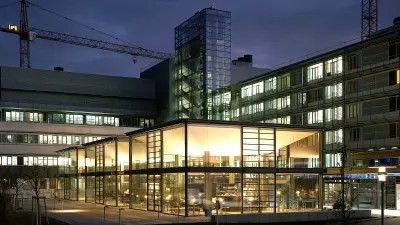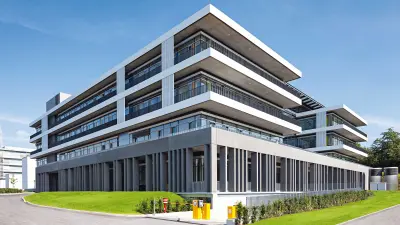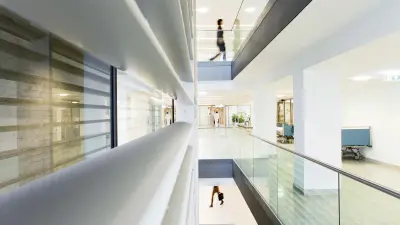A sustainable future for the Robert Bosch Hospital
It really is a mammoth undertaking: in order to realize a huge increase in its energy efficiency, the Robert Bosch Hospital is working together with Bosch to make its energy center and its building automation fit for the future. That said, there’s plenty of challenges – from KRITIS to remodeling in confined spaces – that the experts will need to overcome.

The vision: an energy-efficient, sustainable operation of the hospital
Physicians would call what Bosch is about to perform at Stuttgart’s Robert Bosch Hospital (RBK) a complicated procedure. The measures to modernize the steam, heating, cooling, and ventilation systems are expected to be completed by mid-2021, and the renovation of the building control system should be finished in 2022 – all of which will be carried out while hospital operations continue as normal; after all, patient care must be guaranteed around the clock. The goal is to increase energy efficiency significantly, to save costs, and make operation of the hospital even more sustainable.

A hospital that cares for around 44,000 patients a year is, of course, going to harbor quite a few ‘energy guzzlers’. These include cooling processes – such as ones used for server cooling or ventilation systems, along with the hospital kitchen, large items of medical equipment, and the production of steam for the sterile services department. “Add to this the steadily rising costs of energy,” as Raphael Vogel, the project developer in charge at Bosch, says. This, in turn, increases the costs involved in running the entire hospital. The systems in use at Robert Bosch Hospital run well, but some of them are already anything from 15 to 25 years old – which shows that there is an undeniable potential for optimization. Marius Kaiser, lead project manager at Bosch, explains, “In terms of energy efficiency, the innovative solutions we can offer today are able to exploit technologies that simply didn’t exist back then.”

We have created an optimal basis for every aspect of building automation that the future might bring.

Everything needs to keep running all the time
In addition to energy efficiency, the modernization is pursuing another objective: Robert Bosch Hospital, due to its high utilization rate, has been classified as an “operator of critical infrastructure” (KRITIS). This means that the hospital needs to be able to cater to highly specific and specialized technological requirements – and Bosch’s new solution will help it do exactly that. “In the event of an outage, the providers must be able to guarantee that patient processes remain unaffected,” explains Frank Schmidt, head of project management for Energy Services at Bosch. That also includes all systems used to supply steam, cold, air, and heat at the clinic.
The current KRITIS regulation for hospitals has only been in effect since 2019, so it is still new for all parties involved and is placing immense cost pressure on the hospital. However, Bosch gained experience with KRITIS in other areas in the past, for example at Stadtwerke München, Munich’s municipal utilities. This was something that the experts could profit from during the planning stage. “The tips that Bosch gave us were worth their weight in gold,” says Steven Mashburn, acting technical director at the RBK.
A powerful combination
Before making a start on the modernization work, however, the Bosch experts had to carry out inventory and potential analyses. What do we have? What do we need? Where can we make optimizations? Where are there potential cost savings? Work on defining potential cost savings was followed by a detailed analysis and now, since November 2020, the actual conversion. “Planning was quite a challenge,” Raphael Vogel recalls. “After all, this is an existing building, and we aren’t just putting up a new structure on a greenfield site. This means that we have to put the existing infrastructure to good use.”
Nonetheless, numerous workshops and close cooperation with the foundation hospital allowed them to come up with a plan that everyone is happy with. In order to achieve the defined goals and fully exploit the potential, a new solution was needed – in the case of this hospital, its solution builds up on a potent combination of factors: “We have created a holistic energy concept here that combines the best of smart building automation and sustainable energy management systems,” as Jörg Morkes, project manager at Bosch Building Automation GmbH, says.
KRITIS refers to critical infrastructure. According to the definition used by the German Federal Office for Information Security (BSI), KRITIS organizations or institutions are those with a major importance for the state and the community. Outages or disruptions within institutions like these would, among other things, result in supply shortages or significant disruptions to public safety. To prevent this from happening, institutions such as Robert Bosch Hospital must use high-tech installations to guarantee uninterrupted patient care. The BSI defines which institutions have to meet which requirements in its KRITIS ordinance.
Old body, new brain
Automation systems in the energy center, for example, which houses the hospital’s entire supply technology – including the heating, air conditioning, ventilation, and plumbing systems – are being brought up to scratch by integrating new automation systems.
“We can’t just dismantle everything here – which is why we’re migrating our solution, something we think of as a new brain, into the existing systems,” says Jörg Morkes in explaining the ongoing modernization work. The oldest switch cabinets, cabling, and sensors will, however, still be replaced. The building automation network is used to connect all the new automation systems to each other, which communicate using a special communication protocol.


The actual heating systems will ultimately be comprised of three hot water boilers, two steam boilers, and a combined heat and power plant (CHP), which will allow massive savings to be achieved in energy costs.
CHPs are small power plants that combine heat and power generation to allow decentralized production of electricity and heat. A motor in the CHP powers a generator that produces electricity. This generates waste heat which is converted into heat output for use elsewhere. For this to work, however, all of these systems need to have been installed: “Implementing the conversions while operations continue will be a logistical tour de force,” says Frank Schmidt. “There must be two steam boilers ready for operation at all times, and two hot water boilers must be kept running.” This means carefully dismantling and transporting old equipment away according to plan – and all this in very cramped conditions. “It’s like Tetris,” is how the project manager describes it.
€1.3 million
the RBK is expected to save in energy costs every year
Showing creativity and skill
“An absorption refrigerator represents an invaluable upgrade to the heating system. For me, it’s a real highlight,” as Frank Schmidt shares. The absorption refrigerator is connected to the heating system, and converts excess heat from the CHP for use in cooling processes. In another step, the systems used for cooling distribution and ventilation will also be optimized. It is hoped that the new Bosch solutions will provide savings of up to €1.3 million per year in energy costs. The CHP alone will account for two-thirds of this total.
In addition, a new control system strategy will make additional energy savings possible. One example of this is the cooling distribution system. As lead project manager Marius Kaiser explains, “There are two on-site cooling centers that are connected to each other. Today, the two centers run self-sufficiently. In the future, we will combine both centers into one control concept, which will allow us to operate whichever refrigerators are the most efficient for the current load case. The many individual solutions previously used made this impossible."
The modernization measures also include a completely new web-based management and operating system. Because it boasts a huge range of individually configurable settings and interfaces, it can be used to carry out any number of adjustments – and thereby cater to customer requirements. As Jörg Morkes explains, “Our integrated, intuitive system makes managing and visualizing operating figures much more convenient.” This also helps facility management with troubleshooting, and makes the monitoring of energy consumption more straightforward.

About 12,000
hardware data points will be migrated over the course of modernization work.
There's even more to come!
The end of the implementation phase won’t, however, mark the end of the partnership between Bosch and the hospital. Over the course of the seven year operating phase following the conversion, the energy savings will be guaranteed, maintenance and servicing work will be carried out, and further savings potential will be sought together with the hospital.
Robert Bosch Hospital knows that it can place its trust in Bosch Building Automation GmbH. After all, hospital managers have been working with Bosch on the upgrading their energy management system since 2015.
“We are happy to have obtained our solutions from a single supplier. If any challenges arise, we can count on our partners from Bosch,” as Frank Kohler, business director at the RBK, says. “To date, everything has happened fast and without any complications.”


Our systems are sustainable and will remain available for at least 20 years to come.
Solutions and services for the Healthcare Industry
We develop, supply and install integrated, state-of-the-art healthcare solutions from A to Z in Europe and the USA.
Benefit from our comprehensive competence and experience, 360° approach to every project, and strong partners. We’ve proven our capabilities with a long roster of successfully implemented projects.
Our experts are as experienced in retrofit projects as they are in new construction.
You can find more information here:
> Climatec’s Healthcare Solutions in the USA
> More reference projects on our German website
> Healthcare Industry solutions on our Dutch website
> Healthcare IT solutions from our Canadian subsidiary Paladin Technologies
> Life safety and security solutions for Singapore
Working together for green buildings
Find out how our smart solutions and customized services are promoting sustainable buildings, climate neutrality, and environmental awareness.

Further reading


